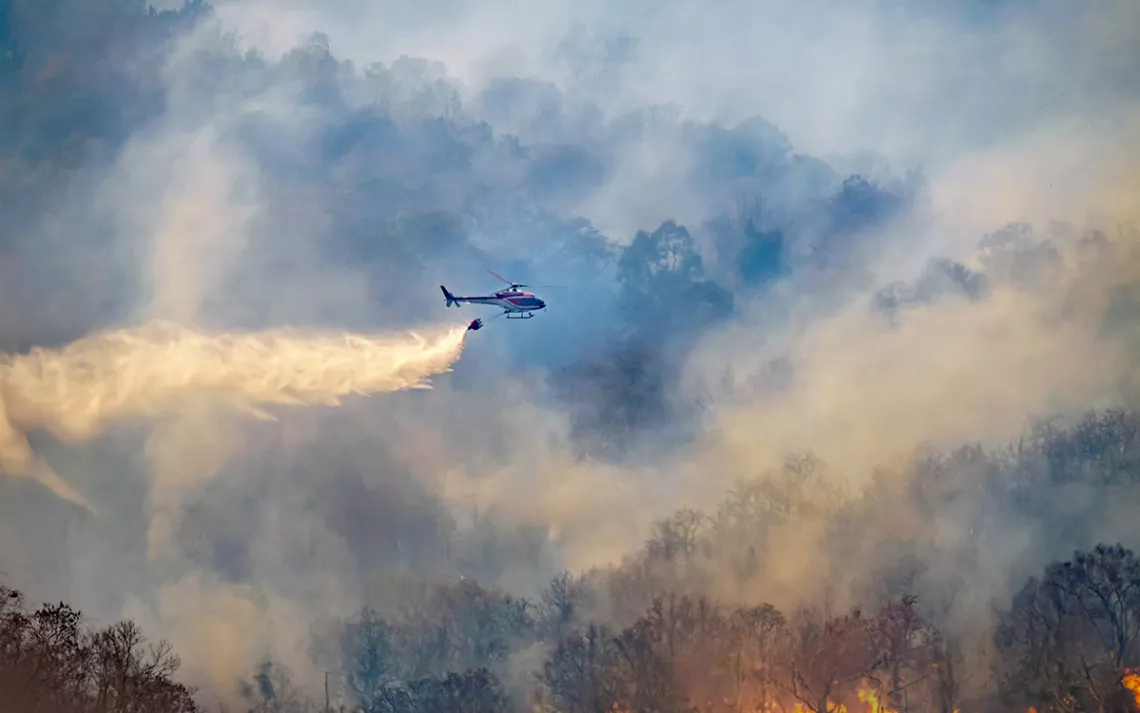Some Fires Are Better Than Others
California’s forests aren't storing as much carbon as they used to. Here's why.

Photo by Toa55/iStock
For a long time, the Karuk, the Yurok, the Mono, and many other tribes across California challenged the belief long held by forest managers across the state that allowing small, controlled fires in forests increased the risk of runaway wildfires. Scientific research has backed up those tribes, showing that small, managed low-intensity fires reduce the risk of larger, unplanned fires burning out of control. According to research published this month in Proceedings of the National Academy of Sciences, allowing small fires has a climate benefit too. The bigger a forest fire, the longer it takes for that forest to regain its carbon-capturing ability. It’s a finding with big implications for California’s plan to use its forests to reduce the state’s carbon emissions and achieve carbon neutrality by 2045.
Normally, when people talk about the carbon released in a wildfire, said Kyle Hemes, the lead author of the new paper, they think of the carbon stored in wood. Which makes sense: Trees take carbon from the atmosphere and store it within their tissues. “In a severe fire, that gets incinerated, and that carbon that was in the tree trunk is now in the atmosphere,” said Hemes, “but that’s not what we’re measuring.” Hemes, who completed the research as a postdoctoral researcher at Stanford, worked with a team of other researchers to crunch data on several thousand forest fires across the state and calculate the quantity of carbon that would go uncaptured during the period when the burned areas were regrowing. This paper is one of the first to look at the carbon opportunity cost of lost photosynthesis, rather than focusing on carbon released from burning wood.
Until the early 1900s, most forest fires in California—whether they were planned or not—were small, frequent, and didn’t burn especially hot. They released carbon dioxide into the air as they burned, but the vegetation in the areas they cleared grew back quickly and began to take up carbon from the atmosphere at the levels that it had before the fire within 12 years, on average.
But forests have changed in recent decades. In the West, climate change has led to droughts and higher temperatures. Additionally, over a hundred years of fire suppression in California has meant that some forests have gone unburned for too long, and leaf litter, twigs, and debris—all fuel for fires—have built up and turned the landscape into a tinderbox. Vegetation mismatch, or when plants are no longer suited to the climate in which they are growing, could also be increasing the risk of catastrophic wildfires, according to other research from the lab of Chris Field, a professor of earth system science at Stanford University and a coauthor of the paper.
These larger and hotter fires kill more mature trees, which are invaluable for storing carbon. All that wood stores more carbon than younger trees, or other types of vegetation. A mature tree can take decades to regrow, and as climate change alters Western ecosystems, they might not grow back at all.
To determine how the changing characteristics of fire has altered carbon uptake, the team used a combination of data collected from eddy covariance towers (which measure the change in carbon dioxide in the air and the flow of that carbon dioxide in/out of vegetation) with satellite data measuring vegetation cover after over 5,000 fires in California between 1919 and 2018. The results showed that the largest 20 percent of fires reduced carbon uptake per cubic meter per year by more than twice as much as average-size fires. The team also found that forests took more than two decades to recover after that largest 20 percent, compared with the average 12-year recovery time.
This increase in severity and the recovery time has resulted in a cumulative loss of carbon equivalent to about ~2.7 percent of California’s yearly total greenhouse gas emissions. That’s about 9.9 million metric tons of extra carbon lost to the atmosphere, equivalent to the emissions from driving more than 2 million gas-powered vehicles for one year.
We know that fires across California are larger and more severe than they used to be, said Winslow Hansen, a forest ecologist at the nonprofit Cary Institute of Ecosystem Studies who was not involved in the new paper. That shift could lead to even more lost carbon storage in the future. “This is really an exciting paper because it allows us to look and quantify this aspect of the carbon cycle over a much broader domain,” Hansen added. “One of the grand challenges we face is figuring out how to provide a more precise and complete picture of carbon dynamics in really rapidly changing ecosystems.”
California’s climate goals depend on managing its natural and working lands, which include forests, as a carbon sink. The state has acknowledged that prescribed burning can have long-term climate benefits, even if it increases carbon emissions in the short term.
But managing forests that way comes with challenges, said Hansen. Forest managers have to take care that prescribed burning won’t threaten people’s houses or choke public places with smoke. “If California wants to be successful with its land management, dealing with fires is going to be an important part of that,” said Field. “Moving us back to the historical situation, where fires tended to be smaller and less intense, would help us get to a situation where the natural and working lands are providing a benefit for California reaching its climate goals.”
 The Magazine of The Sierra Club
The Magazine of The Sierra Club



